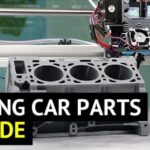Routine car maintenance often includes a multi-point inspection by mechanics during services like oil changes and tire rotations. While many trust their mechanic’s expertise to identify issues under the hood, understanding the basics yourself is incredibly beneficial. Whether for roadside emergencies or simply to appreciate how your vehicle operates, knowing the parts under your car hood is empowering.
This beginner-friendly guide from carparteu.com will walk you through the essential Parts Of A Car Hood, helping you become more familiar with the components that keep your vehicle running smoothly. Let’s lift the hood and explore!
Engine: The Heart of Your Vehicle
Let’s start with the most crucial component – the engine. Considered the heart of your car, the engine is the powerhouse that converts fuel into motion, propelling your vehicle forward. Typically the largest component under the hood and centrally located, the engine is unmistakable. For detailed information specific to your engine model, always refer to your car’s user manual. This will provide valuable insights into its operation and maintenance.
Alternator: Charging the System
If your car struggles to start, the issue could stem from either the battery or the alternator. The alternator is easily identifiable as a wheel-like component with slits and gears on its side. Its primary function is to generate electrical power while the engine is running. This power not only keeps the engine operating but also recharges the battery, ensuring consistent starts and electrical function.
Battery: Powering the Start
The battery is usually straightforward to locate, often situated in a corner of the engine compartment, although some vehicles may have a protective cover. It’s typically a rectangular box with distinct red and black terminals. Red signifies positive, and black denotes negative. The battery provides the initial electrical energy to start the engine and powers electrical components when the engine is off.
Belts: Driving Engine Accessories
Belts are essential for managing various engine operations, powering components like the alternator, air conditioner, and power steering pump. Many modern cars utilize a single serpentine belt, a long, winding belt with ribs on one side and a flat surface on the other. This belt wraps around multiple pulleys on the engine, efficiently driving these accessories.
Cylinders and Spark Plug Wires: Ignition and Power Generation
Engines contain cylinders, the chambers where fuel combustion generates power. Most modern vehicles utilize engines with four, six, or eight cylinders, although variations exist. Each cylinder typically has a spark plug, crucial for igniting the air-fuel mixture. Spark plug wires connect the spark plugs to the ignition system, delivering the electrical spark needed for combustion.
Pistons and Crankshaft: Converting Linear to Rotational Motion
Pistons reside within the cylinders and are connected to the crankshaft. Their up-and-down motion, driven by combustion, translates into rotational motion of the crankshaft. The crankshaft is vital as it converts this linear motion into the rotational energy that ultimately powers the wheels and propels your car.
Oil Fill Cap and Dipstick: Engine Lubrication Management
For those who perform their own oil changes, the oil fill cap is where new engine oil is added. Located on top of the engine, it’s often labeled with “oil fill,” “engine oil,” or an oil can symbol. Nearby, you’ll find the dipstick, used to check the engine oil level. The oil level should ideally be between the minimum and maximum marks on the dipstick for optimal engine lubrication.
Radiator: Engine Cooling System
The radiator is a heat exchanger responsible for cooling the engine and regulating its temperature. Positioned upright behind the front grille, it’s a large panel designed to dissipate heat. Important safety note: Never remove the radiator cap when the engine is hot. The cooling system operates under high pressure and heat, and removing the cap can cause severe burns.
Transmission: Managing Power to the Wheels
The transmission is located towards the rear of the engine, often situated beneath other components, making it less immediately visible. It plays a critical role in transferring power from the engine to the wheels, allowing for gear changes to suit different driving conditions. A dipstick, usually located nearby, is used to check the transmission fluid level, essential for smooth operation.
Reservoirs: Essential Fluids for Vehicle Systems
Brake Fluid Reservoir: Ensuring Braking Power
Typically found under the hood in front of the steering wheel, the brake fluid reservoir is often transparent. This design allows for quick visual checks of the brake fluid level without needing to open the reservoir. Maintaining the correct brake fluid level is crucial for a responsive and effective braking system.
Coolant Reservoir: Preventing Overheating
Situated near the radiator, the coolant reservoir holds the engine coolant. These reservoirs are generally made of translucent white plastic, allowing you to see the coolant level. Proper coolant distribution is vital to prevent engine overheating and potential engine damage.
Power Steering Fluid Reservoir: Ease of Steering
Power steering fluid reservoirs are commonly found on either the passenger or driver’s side of the engine compartment. The cap usually has a small dipstick attached for checking the fluid level. Power steering fluid ensures smooth and effortless steering. If you notice increased resistance when turning the steering wheel, checking the power steering fluid level is a good first step.
Windshield Washing Fluid Reservoir: Maintaining Visibility
The windshield washer fluid reservoir is perhaps the easiest to identify and refill. Located around the sides of the engine compartment, it usually has a cap with a windshield symbol or liquid droplets, often in blue. Keeping this reservoir topped up is essential for maintaining clear visibility while driving, especially in inclement weather.
Carparteu.com: Your Partner in Automotive Knowledge
Understanding the parts of a car hood and the components beneath it empowers you as a vehicle owner. This basic knowledge is invaluable for routine maintenance and handling unexpected situations. Whether you are performing DIY maintenance or simply want to be more informed about your vehicle, carparteu.com is here to provide expert guidance and information to keep you safely on the road.
